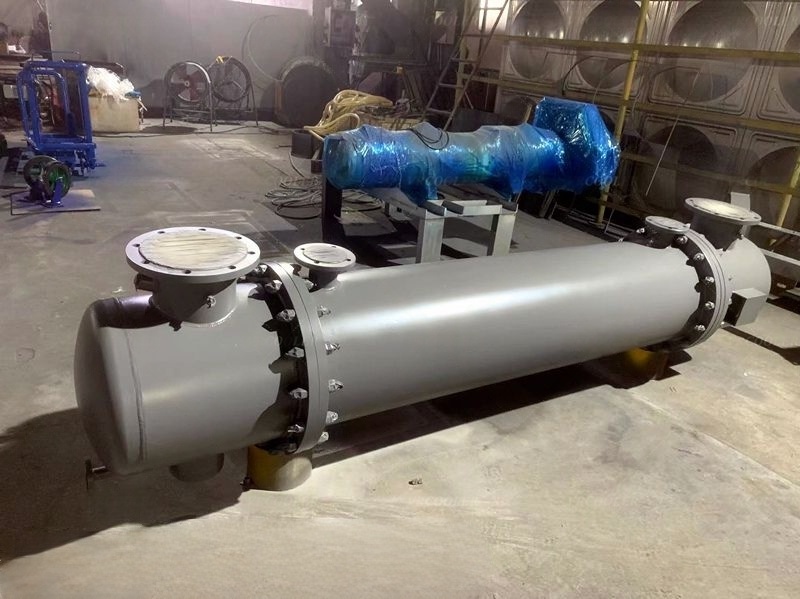The Shell and Tube Oil Cooler is constructed using materials chosen for thermal conductivity, corrosion resistance, and mechanical strength. Here’s a breakdown of the typical materials of construction (MOC) for each component:
1. Shell (Outer Casing)
- Carbon Steel (CS)
- Pros: Low cost, high strength.
- Cons: Prone to rust; often lined/coated for wet service.
- Use Case: Industrial applications with non-corrosive fluids.
- Stainless Steel (SS 304/316)
- Pros: Corrosion-resistant, durable.
- Cons: More expensive than carbon steel.
- Use Case: Marine, chemical, or high-purity applications.
- Titanium
- Pros: Excellent for seawater/saltwater cooling.
- Cons: Very high cost.
- Use Case: Offshore, desalination plants.
2. Tubes (Heat Transfer Surface)
- Copper
- Pros: High thermal conductivity, easy to fabricate.
- Cons: Weak against ammonia/sulfide corrosion.
- Use Case: Low-pressure lube oil cooling.
- Stainless Steel (SS 316/316L)
- Pros: Resists chlorides, acids, and scaling.
- Cons: Lower thermal conductivity than copper.
- Use Case: Hydraulic oil, chemical processes.
- Titanium
- Pros: Unmatched corrosion resistance (seawater, acids).
- Cons: Extremely expensive.
- Use Case: Marine, power plants.
- Admiralty Brass (Cu-Zn-Sn alloy)
- Pros: Good corrosion resistance in freshwater.
- Cons: Not for salty/contaminated water.
- Use Case: HVAC, light industrial.
3. Tube Sheets (Holds Tubes in Place)
- Carbon Steel + Cladding
- Clad with SS or titanium for corrosion protection.
- Stainless Steel (SS 304/316)
- Common for chemical/food industries.
- Titanium
- Used with titanium tubes in aggressive environments.
4. Baffles (Direct Fluid Flow)
- Carbon Steel (cheap, for non-corrosive fluids).
- Stainless Steel (corrosive or high-purity systems).
5. Gaskets & Seals
- Nitrile Rubber (NBR)
- For standard oils and water.
- EPDM
- Resists heat and steam.
- Viton (FKM)
- For high-temp/high-chemical resistance.
Material Selection Guide by Application
| Application | Recommended Material | Reason |
| Marine/Offshore | Shell: CS/SS316, Tubes: Titanium | Saltwater corrosion resistance |
| Industrial Hydraulics | Shell: CS, Tubes: SS316 | Balance of cost & durability |
| Power Plants | Shell: CS, Tubes: Admiralty Brass | Freshwater cooling |
| Chemical Processing | Shell & Tubes: SS316/Titanium | Acid/chemical resistance |
| Automotive | Shell: CS, Tubes: Copper | Cost-effective for low pressure |
Key Considerations
- Corrosion Resistance – Match materials to fluid chemistry (e.g., seawater → titanium).
- Thermal Conductivity – Copper > SS > Titanium (but trade-offs with cost/durability).
- Pressure/Temperature – Carbon steel for high pressure; SS/titanium for high temp.
- Cost – Carbon steel + copper = budget-friendly; titanium = premium.
Comparison Table: Tube Materials
| Material | Thermal Conductivity | Corrosion Resistance | Cost |
| Copper | Excellent (385 W/mK) | Poor (ammonia/sulfide) | Low |
| SS 316 | Moderate (16 W/mK) | Good (acids/chlorides) | Medium |
| Titanium | Low (22 W/mK) | Exceptional | Very High |
Final Recommendation
- For cost-sensitive, non-corrosive apps → Carbon steel shell + copper tubes.
- For corrosive/seawater use → SS316 shell + titanium tubes.
- High-pressure industrial → Carbon steel shell + SS316 tubes.
